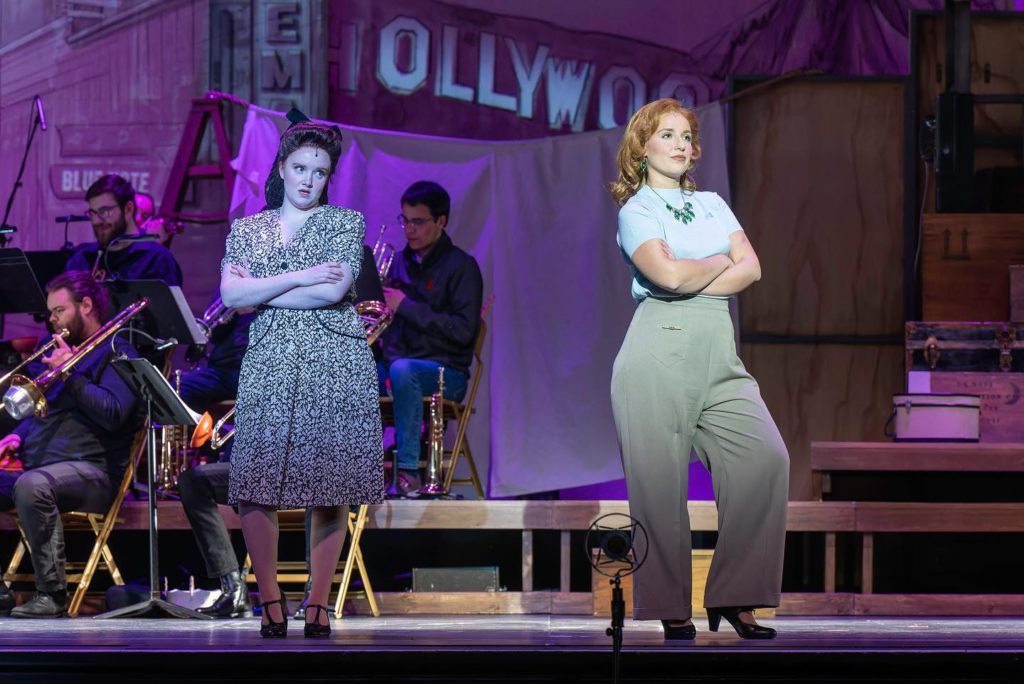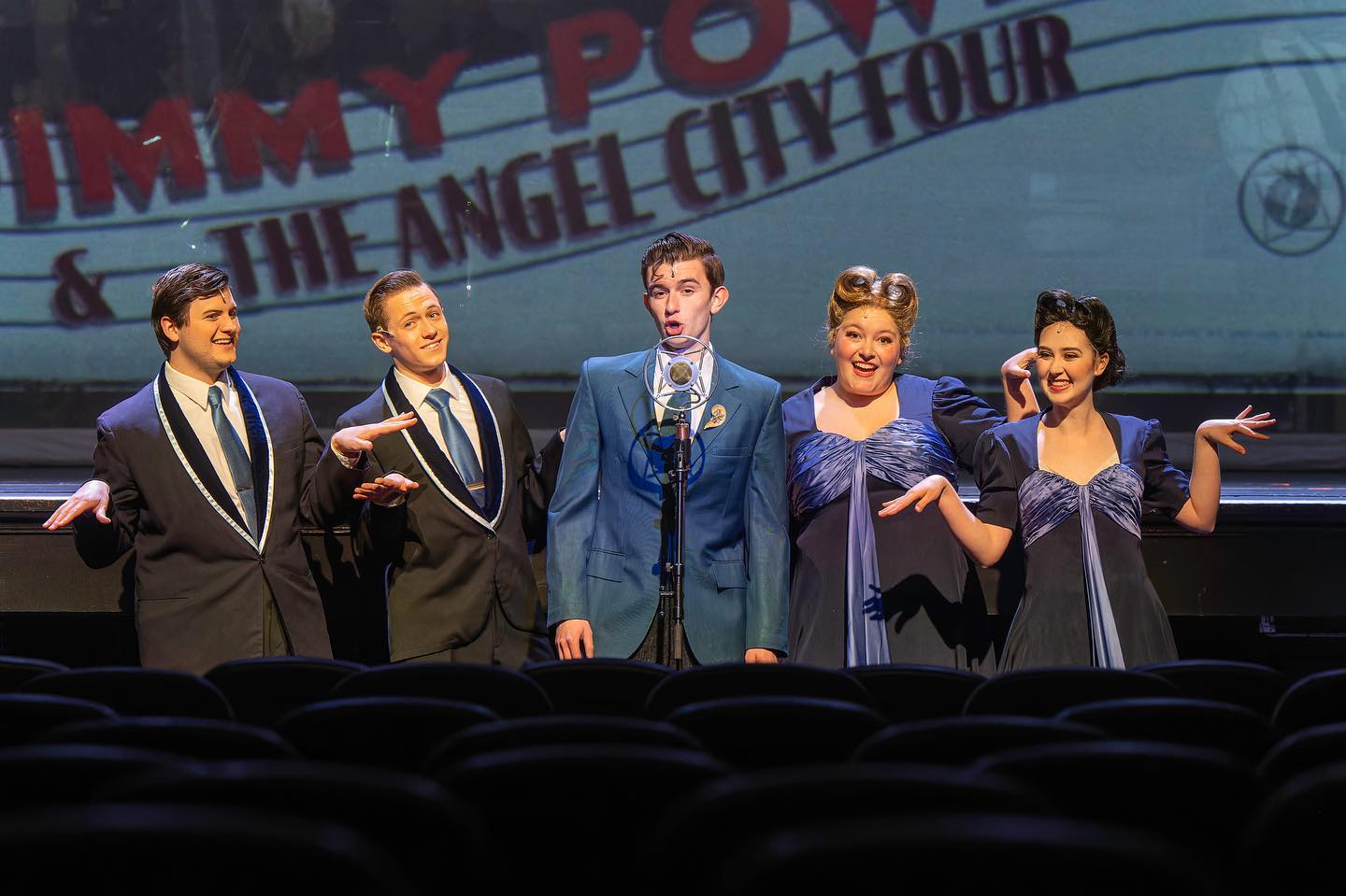On April 13th City of Angels (music by Cy Coleman / lyrics by David Zippel / book by Larry Gelbart) opened at The Virginia Theatre. The Lyric Theatre’s production is a collaboration between the Virginia Theatre and Krannert Center for the Performing Arts. It premiered on Broadway in 1989, and won a Tony Award for Best Musical in 1990.
An ode to 1940s film noir, City of Angels is a satirical meta musical with two simultaneous plots. As viewers and listeners would hope, these two plot lines converge at crucial points in the show. Stage Director Sarah Wigley describes in her show notes:
Just as film noir often invites us to experience its stories from the inside out, City of Angels grants us permission to view the writing of film noir from Stein’s perspective as we are witnessing what it is like inside a noir-style film from Stone’s point of view. Many films underscore their narrator’s subjectivity with the soundtrack presence of that person’s voice interwoven with scenes dramatizing events in that story.
Stine, the main character and a successful novelist, is adapting his latest book into the film that will form one of the two intertwined narratives of the musical.
The production team had some really great fun with the multi- and meta-media nature of this show: it’s a musical about an author who is adapting his novel into a movie. They begin by projecting their intro (and later end credits) on the stage to look like vintage film. The actors and singers also lean into the multi-layered nature of the production through double-cast roles. If you enjoy the kinds of literary references made within a play when, say, the same actor plays both Mr. Darling and Captain Hook in Peter Pan, then this is the show for you. This kind of double-casting is everywhere, and the actors do very well in blurring the lines between their real-life and fictional characters as the show progresses. It’s not a new trope — it wasn’t new in 1989 when Coleman, Zippel, and Gelbart, created the show — but it’s still as fun to watch as ever.
Predictably, the author — always referred to as “Stine” — is the closest thing to a heroic character we really get. He is committed to translating his successful novel into a script instead of adapting it the way the film producer, Buddy Fidler, wants it to be. Fidler is intent on destroying the integrity of the original novel based on “what will sell” and “what will film” — a remarkably contemporary-feeling impulse. The second storyline is that of the novel he’s adapting, and which always seems to follow his off-page life a little too closely. One of the most entertaining conceits of the musical is when Stine makes “revisions”: the actors, singers, and orchestra literally speak, sing, play, and move in reverse when Stine revises and rewrites, sometimes with the sound of a clacking typewriter in the background. To my enjoyment, lines that he cut or revised earlier in the show would turn up later, in different contexts and in the mouths of different characters.
Stine’s main character, a detective named Stone, draws on tropes of hard-boiled detective fiction in addition to 40s noir. He could have walked out of the pages of a novel by Cain, Chandler, or Hammett, with a little of Humphrey Bogart’s Casablanca profile thrown in for good measure. He’s a little two-dimensional, even by this genre’s standards, but that reflects more of how he’s a stand-in for Stine than any actual flat writing. Before the end, author and creation will openly acknowledge and argue with each other — not in a horrific, creation-come-to-life way, but expressive of the tension between the life that Stine is actually living and how he views himself as being much more heroic than he is.
The women in City of Angels are, per the conventions of both hard-boiled detective fiction and film noir, adhering to character tropes of their own. The long-suffering secretary, who cares more about our “hero” detective than she might be willing to admit. The femme fatale, with all of her mystery and sex appeal. The rich ingenue who is maybe a little more worldly than she appears. An independent woman torn between supporting her husband and being the best, most-actualized version of herself. An aspiring actress-turned-prostitute who wouldn’t marry our heroic detective when she had the chance. Director Wigley acknowledges in her notes that such tropes — the femme fatale in particular — are less in line with contemporary tastes than they used to be, and can seem very two-dimensional.

I was surprised to find that this wasn’t my experience at all. The tropes are present, of course. We as viewers and listeners would be disappointed if they weren’t, it wouldn’t be film noir without them. What surprised me the most was that even within those creative constraints, these female characters (and the actors who play and sing them) manage to express genuinely nuanced emotions and exert a remarkable amount of agency in the story. Perhaps their flow between fictional and real-life characters in the two storylines helps them achieve this, as the emotions and more three-dimensional motivations of their real-life characters resonate in Stine’s story.
If I have a criticism of City of Angels, it was small tech misalignments. Occasionally, the on-stage orchestra would drown out the actors. Gelbart’s rapid-fire dialogue sometimes got lost, or sacrificed to the speed at which the actors were speaking to keep the classic fast-talking delivery intact. Microphones helped them a lot, though were regularly visible and periodically lost a few words. Even this must be taken in perspective. When so much about the show and the on-stage work is so good, it’s easy to notice when small details stick out.
By the end of the show, I was surprised by the balance of nostalgia and depth that Lyric Theatre achieved with City of Angels. What could have been merely a two-dimensional salute to film noir turned out to be a much more human statement.








